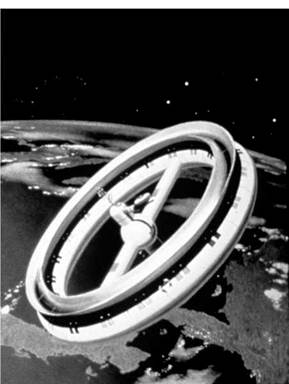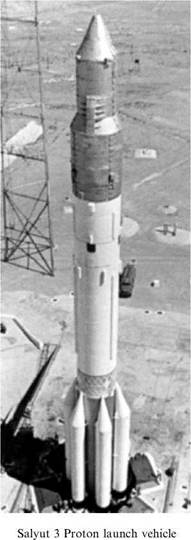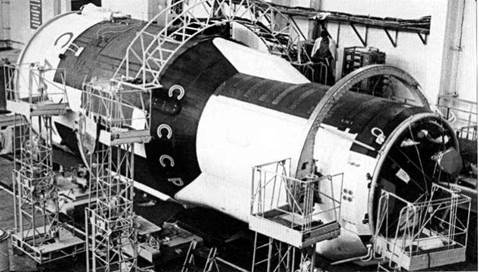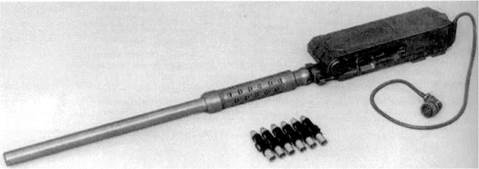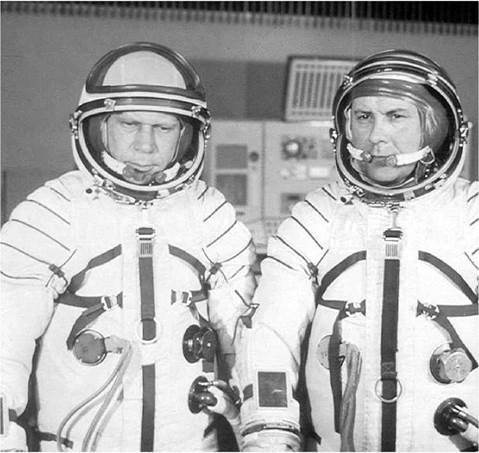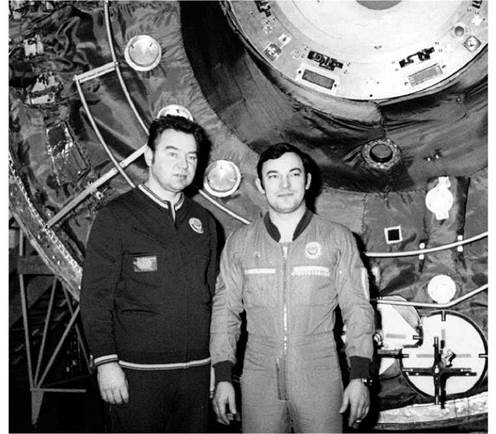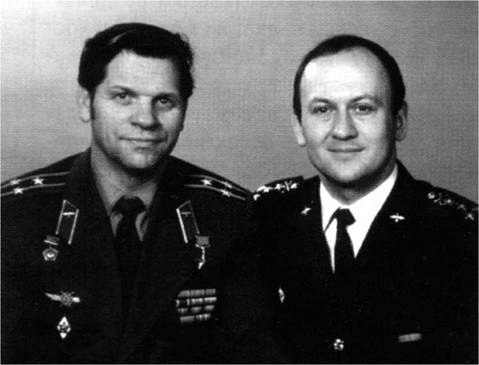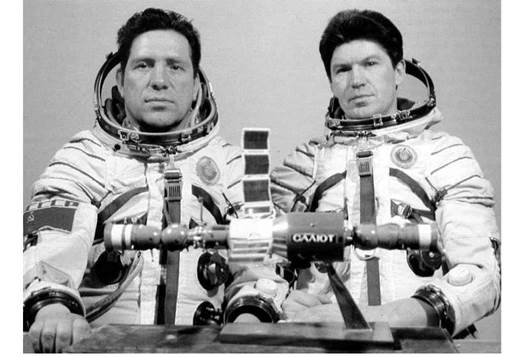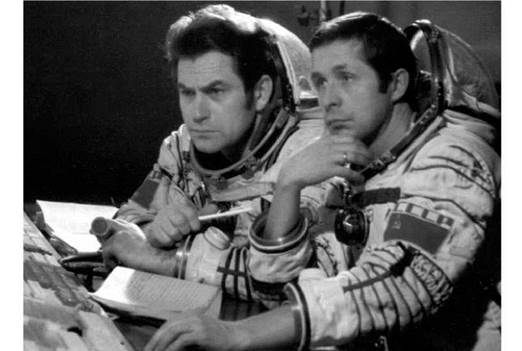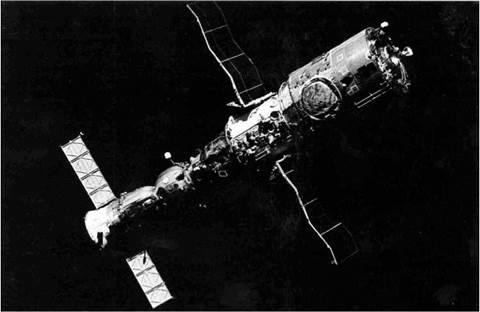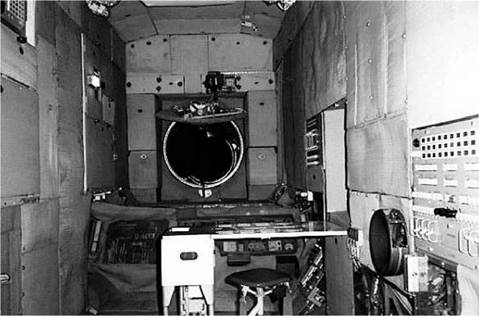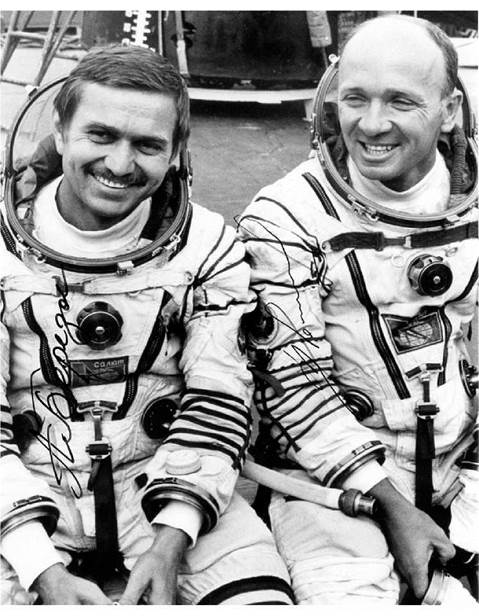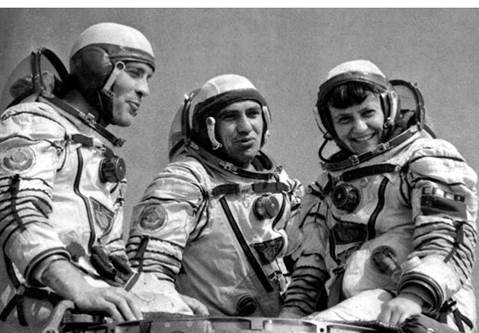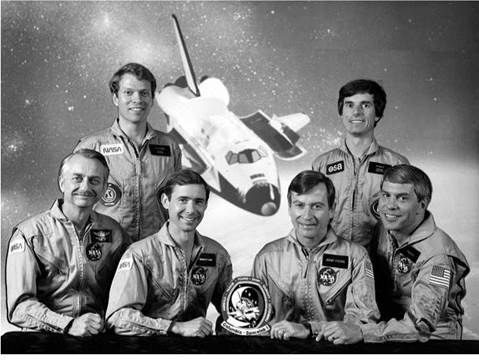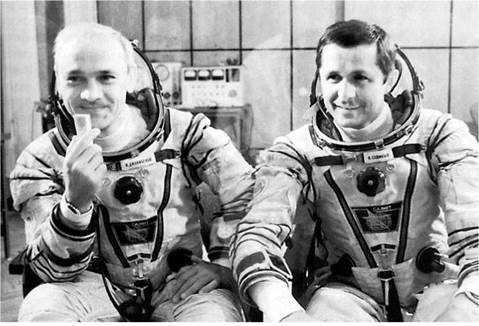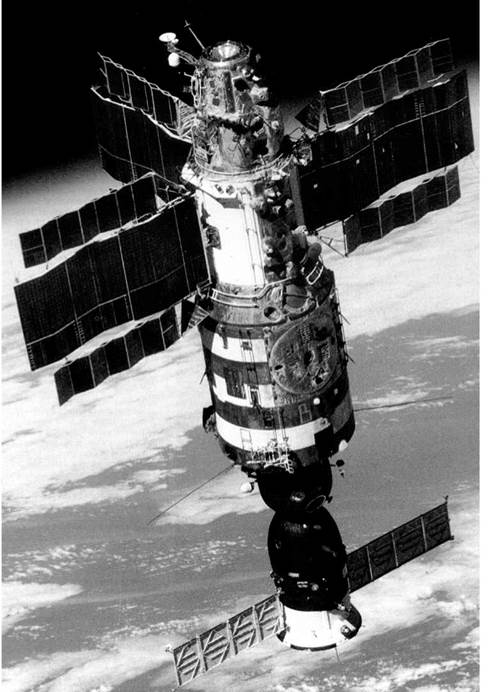Salyut 4 differed from Salyut 1, the previous successful DOS design, by having three sets of solar arrays, just as the doomed Cosmos 557 had. It also included some additions for crew comfort, including a table for the crew to eat at which supplied hot and cold water for rehydrating their food packs. The navigation system for the station was now semi-automatic, to allow the crew more time for experimentation. It was launched on 26 December 1974, and was followed on 11 January 1975 by Soyuz 17 with a crew of two, Alexei Gubarev and Georgi Grechko, both making their first space flights.
Their docking was achieved effortlessly, and they soon settled into the mission, working for six days a week, with a day off to spend largely as they wished. Their enthusiasm for their work was such that they worked longer hours than anticipated, and also ate more than planned, which had to be controlled as there were only so many supplies on board. Eventually they were told to slow down and take more time off, which they reluctantly did. The Soviets were still working to discover the best compromise between work and rest for the cosmonauts’ working week. The crew returned to Earth on the 7 February after 30 days in orbit, a new Soviet record of endurance, and were found to be in good physical and mental shape. However, it was decided that the exercise regime for future crews would be stepped up slightly, especially in the later stages of the mission to ensure that they were in the best condition for re-entry and adaptation to Earth’s gravity.
The launch of Soyuz 18 on 5 April was rather more dramatic, and once again the Soviets failed to get a mission to a space station. A fault with the separation of the main booster stage caused the abort tower to be used for the first time in manned spaceflight, causing the crew, Vasili Lazarev and Oleg Makarov a very uncomfortable 15-g ride before the capsule landed in snow. The next launch attempt on 24 May was also called Soyuz 18, and the previous failed flight simply referred to as “the 5th April anomaly’’. This crew, Pyotr Klimuk and Vitali Sevastyanov, reached orbit successfully, and docked with Salyut 4. Their task was essentially to carry on the
|

Soyuz 17 crew shortly before lift-off
|
work started by the previous crew, but this time the Soviets tried to schedule the workload more logically. They would work for several days on one type of experiment before moving on to the next; a significant step forward. Of course, there was also maintenance work on the station to be carried out between scientific experiments, but again experience from previous missions was paying off, as items such as filters, pumps etc., had been made much easier to replace and service than previous designs, cutting down on time and frustration.
A new mission was launched on 15 July 1975. Although this mission did not involve Salyut 4, it did signify the first co-operation between the Soviet Union and the United States of America: ASTP, or Apollo-Soyuz Test Project. Discussions for such a mission had been taking place for several years, as mentioned in an earlier chapter, but the options were soon narrowed down to one: the docking of an Apollo Command and Service Module with a Soyuz spacecraft. On 24 May 1972, U. S. President Richard Nixon, and Soviet Chairman Alexei Kosygin, signed the agreement that would make ASTP a reality. It was part of a much larger agreement that covered all manner of scientific co-operation, including space flight. Despite the air of cooperation, there remained “discussions” about various aspects of the mission. Which spacecraft would launch first? NASA assumed that Apollo with its longer mission duration would be the first to launch. That way if Soyuz was delayed for any reason, Apollo could simply wait until it arrived. The Soviets disagreed, stating that they would launch first, and wait for Apollo; if Apollo were delayed, they would launch a second Soyuz if necessary. This came as something of a surprise to NASA mission planners, as they had not previously heard anything about a second Soyuz being prepared for this mission. The actual docking posed even more problems, both technical and political. What form would the docking mechanism take? Both nations so far had used a male and female docking mechanism; which nation would take which role? The Soviets were rather more chauvinistic in this area, not wishing to take the “lesser” role of the female as they saw it. It was finally agreed that the docking system would be an androgynous one that equalized the two nations, but this also presented another problem. Which spacecraft would be the active (moving) ship, and which would wait (stationary) for the docking? The Apollo was clearly the more maneuvrable spacecraft, and so the Soyuz would have to wait to be docked with by the Apollo. Unfortunately, the problems did not end there. The atmospheres of the two spacecraft were very different. Apollo’s atmosphere consisted of 100% oxygen at a pressure of 0.34 atmosphere, whilst the Soyuz was an oxygen/nitrogen mix at 1.0 atmosphere. Clearly, it would be possible to simply float from one spacecraft to the other without suffering from the bends, so the docking mechanism would also have to double up as an airlock. With modifications to both spacecraft to allow the lowering of cabin pressure to make the transfer between the two craft quicker achieved, the major technical problems had been overcome. The first of the two crews were announced in 1973; the U. S. crew would consist of commander Tom Stafford who had previously commanded Apollo 10 and Gemini 9, and flown as pilot on Gemini 6. The Command Module Pilot would be Vance Brand, who would be making his first space flight after backing up the last two Skylab crews. The third crewmember had been waiting for a flight for a long time, after years of selecting other astronauts for their missions Deke Slayton, a member of the original Mercury astronaut group, would finally make it into orbit. The Soviets followed with their own crew announcement a few months later. This was a first, as crews for Soviet space flights had never been announced in advance before. The commander of Soyuz 19 would be Alexei Leonov, who we know all about from his travails during the crew selection for Soyuz 11. His flight engineer would be Valeri Kubasov, who had been removed from the Soyuz 11 crew for medical reasons, but was long since recovered. He had flown
|
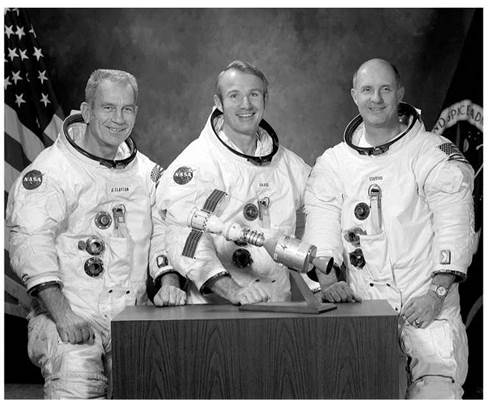
U. S. ASTP crew
|
previously on Soyuz 5 and had spent time on Salyut 6; in fact he had more flight experience than his commander.
With the crews announced, training for the flight could now begin. Learning each other’s language proved to be the most difficult task for both crews; something that would not change much over the coming years. The problem did not end with the crews of the spacecraft, the ground controllers and technical experts also needed to get up to speed on their counterparts’ language, a task that is particularly difficult where technical jargon is concerned.
Apollo-Soyuz finally got underway when Soyuz 19 was launched on 15 July 1975. With Soyuz safely established in orbit, Apollo was launched to give chase. Almost two days later, the two spacecraft docked without difficulty. The two crews spent 47 hours docked together, with members of each crew visiting the other’s spacecraft. Mission rules dictated that neither vehicle would be left unmanned at any time. After the docked phase of the mission Soyuz 19 returned to Earth almost immediately even though this Soyuz was equipped with solar panels like previous versions, and could stay in space for longer than its space station specific counterparts. Apollo stayed in orbit for a further three days to conduct experiments that
|
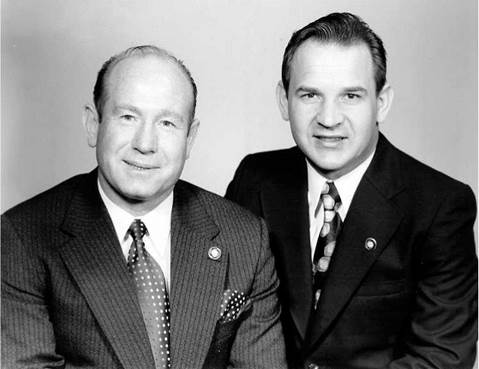
Soyuz 19 crew
|
|

Combined U. S. prime, back-up, and support crews
|
would have to last NASA for a while, this being the last U. S. manned mission until the space shuttle was ready to fly, at this time expected in 1979.
It has been suggested that ASTP was little more than a political show, but this opinion sells the program short. In truth the idea may have been born out of political needs by both the U. S. and the Soviet Union, but that fails to take into account that many of the people that worked on this mission from crews to support staff and technical designers from both countries would later work together again on Shuttle – Mir, and ultimately the International Space Station (ISS). Relationships that were forged during ASTP would endure to smooth new relationships in the 1990s. It has been said that neither side learned very much; the U. S. engineers say that most Soviet equipment was Gemini era to them. But both countries did learn that it was possible to work together, and in the longer run that was sure to be worth something.
Meanwhile the crew of Salyut 4 continued their mission for a few more days before they too returned to Earth on 26 July, after 63 days in orbit. Before their departure they fired the engines of Soyuz 18 to raise Salyut 4’s orbit. This was the first time that such a maneuvre had taken place, previous orbit-boosts had been undertaken using the stations own propulsion. Upon their return the crew walked from their capsule to the medical tent, obviously in better physical condition than previous crews had been. Their mission had paved the way for longer duration flights, possibly involving rotating crews on a new space station. But Salyut 4’s mission was not over. Soyuz 20 was launched on 17 November 1975, and unusually for such a designation it carried no crew. It followed a different flight profile than usual, docking with Salyut 4 after two days rather than the one day that had been flown by manned up until now. Once docked, Soyuz 20 remained powered down until the end of February 1976. It later became apparent that this mission was a test of the flight profile and duration of an unmanned cargo craft. Once the craft had returned to Earth, examinations of its systems led Soviet engineers to place a 90-day limit on the amount of time that a Soyuz could safely spend in space.
Salyut 4 had been a great step forward for the Soviet space station program, after the difficulties of its predecessors, and had proved the procedures and technology that would be needed for the next generation of stations.
The next space station was Salyut 5, and it was launched on 22 June 1976. It quickly became apparent from the telemetry that this was another Almaz reconnaissance platform, identical to Salyut 3, but without the machine gun. An all-military crew of Boris Volynov and Vitali Zholobov was launched on Soyuz 21 two weeks later. The crew carried out some scientific experiments, but their primary mission seemed to involve observations of a military exercise that was underway in Siberia. They seemed set for a fairly long-duration mission, and indeed Soviet radio had reported on 19 August that solar radiation levels were such that the crew would be able to carry out a “prolonged flight’’, but five days later the same radio station reported that the crew were in the process of returning home. When they clambered out of the capsule after a night landing, it became evident that they were suffering from the effects of their mission, most likely because they had not started their prereturn exercise regime. All evidence seemed to point to the fact that the crew had returned much earlier than planned; but why? There were several suggestions, but the most likely seemed to be that the station’s atmosphere had somehow become contaminated causing the crew to abandon ship. One speculation in the West was that one or both crewmembers had suffered mental or physical problems that forced their return. It was also suggested that Zholobov in particular had suffered debilitating homesickness, and as a result had not followed his exercise regime. It has since come to light that perhaps the two crewmembers did not get along, and perhaps their hostility got to the point that returning them to Earth was the only option before physical harm was caused. Whatever the reason, Salyut 5’s first manned mission had been abandoned early, and a crew needed to return as soon as possible to carry on the work. The next flight, that of Soyuz 22, made use of the back-up vehicle from the ASTP mission, and was not a flight to Salyut 5. Soyuz 22 was a week-long flight that concentrated on Earth photography using a special East German built camera. The fact that the next crew to visit Salyut 5 was launched within 2 months of the landing of the previous one, suggested that not too much could have been wrong with the station. The crew of Vyacheslav Zudov and Valeri Rozhdestvensky were to check on the condition of the station, and carry on with the experiments that were still left on board. However, all was not to go smoothly. The mission of Soyuz 23 on 14 October proved to be dramatic. The automatic rendezvous system malfunctioned almost as soon as it reached orbit, and for some reason not made clear by Soviet officials the crew did not attempt a manual approach and docking, but waited for the first opportunity to land. When the landing attempt came, things began to go wrong. After re-entry, the capsule descended on its parachute in the darkness, but was blown off course by a blizzard and it landed in Lake Tengiz. This was not in itself a problem as the Soyuz had been designed to land in water if necessary. Although the capsule landed in relatively shallow water, it was at least 5 miles from the nearest shore, and the water was freezing. Recovery by boat was therefore impossible, and helicopters could not locate the spacecraft as thick fog engulfed the area. The crew were forced to spend a very cold night in the capsule, which by now had no power reserves, and therefore no heating. At first light, the fog had cleared sufficiently to allow helicopters to attach lines to drag it to shore and end the exhausted crew’s ordeal. As it was, no real damage was done, but it is worth reflecting on what might have happened to a more weakened crew that had perhaps spent months in orbit, or been forced to come home early…
Viktor Gorbatko and Yuri Galzgov were launched on 7 February 1977 on Soyuz 24 for what would prove to be a short mission. Again when an automatic docking was attempted the system failed, but on this occasion a manual docking was attempted and achieved. The crew entered the station wearing breathing apparatus, but it did not take long to determine that the air was clear. Whether this procedure was really necessary, only the Soviet space officials know. However, the crew did take the opportunity to test a new procedure to clear the station’s atmosphere of any potential contaminants. They had brought some equipment with them that would allow the existing atmosphere to be vented and replaced with fresh supplies of air stored on board. Basically, the old air was allowed to leak out of one end of the station whilst at the same time fresh air was pumped in at the other end. Interestingly, the crew remained on board the station whilst this procedure was carried out, rather than retreating the Soyuz as one might expect. Shortly after this test, the crew began to prepare to come home, packing up their experiments as well as those left behind by the Soyuz 21 crew. The combined equipment and experiments were far more than the Soyuz could return by itself, so use was made of Salyut 5’s own descent capsule, designed for just such a purpose; it would return to Earth a day after the crew. The station had been left in a good state of repair, and Anatoli Berezovoi and Mikhail Lisun were already in training to attempt an unprecedented third period of occupancy, but due to the run of ill-luck the Soyuz spacecraft that had been allocated to the Salyut 5 programme had all been used, and there simply was not the budget nor the time to build a new Soyuz during the remaining lifetime of Salyut 5. Soyuz 24, therefore, became the last mission to a military space station. Salyut 5 re-entered the atmosphere on 8 August 1977 when all of its remaining fuel had been depleted, and it was clear that it would host no more missions.











